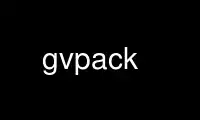
This is the command gvpack that can be run in the OnWorks free hosting provider using one of our multiple free online workstations such as Ubuntu Online, Fedora Online, Windows online emulator or MAC OS online emulator
PROGRAM:
NAME
gvpack - merge and pack disjoint graphs
SYNOPSIS
gvpack [ -nguv? ] [ -mmargin ] [ -array[_flags][n] ] [ -ooutfile ] [ -sgraph_name ] [
-Gname=value ] [ files ]
DESCRIPTION
gvpack reads in a stream of graphs, combines the graphs into a single layout, and produces
a single graph serving as the union of the input graphs. The input graphs must be in dot
format, and must have all necessary layout information. Acceptable input is produced by
applying a Graphviz layout program, such as dot or neato, with no -T flag.
By default, the packing is done at the cluster level. Thus, parts of one graph will not
intrude into any top‐level clusters or overlap any nodes or edges of another.
The output of gvpack can be used to produce concrete output by applying neato -s -n2 with
the desired -T flag.
OPTIONS
The following options are supported:
-g Combines the graphs at the graph level. This uses more space, but prevents parts of
one graph from occurring between parts of another.
-array[_flags][n]
Combines the graphs at the graph level, placing them in an array. By default, the
layout is done in row-major order. The number of columns used is roughly the square
root of the number of graphs. If the optional integer n is supplied, this indicates
the number of columns to use.
If optional flags are supplied, these consist of an underscore followed
by any of the letters "c", "t", "b", "l", "r", "u" or "i". If "c" is supplied, the
graphs are packed in column-major order, in which case a final integer specifies
the number of rows. The flags "t", "b", "l", "r" indicate that components are
aligned along the top, bottom, left or right, respectively. By default, the
insertion order is determined by sorting the graphs by size, largest to smallest.
If the "u" flag is set, the graphs are sorted based on the non-negative integer
sortv attribute attached to each graph. The "i" flag indicates that no sorting is
done, with the graphs inserted in input order.
-Gname=value
Specifies attributes to be added to the resulting union graph. For example, this
can be used to specify a graph label.
-mmargin
Packs the graphs allowing a margin of output points around the parts.
-n Combines the graphs at the node level. Clusters are ignored in the packing.
-ooutput
Prints output to the file output. If not given, gvpack uses stdout.
-sgraph_name
Use graph_name as the name of the root graph. By default, "root" is used.
-u Don't pack the graphs. Just combine them into a single graph.
-v Verbose mode.
-? Prints usage information and exit.
OPERANDS
The following operand is supported:
files Names of files containing 1 or more graphs in dot format. If no files operand is
specified, the standard input will be used.
RETURN CODES
gvpack returns 0 if there were no problems, and non‐zero otherwise.
EXAMPLES
ccomps -x abc.gv | dot | gvpack | neato -s -n2 -Tps
This pipeline decomposes the graph in abc.gv into its connected components, lays out each
using dot, packs them all together again, and produces the final drawing in PostScript. Of
course, there is nothing to prevent one from using different layouts for each component.
Use gvpack online using onworks.net services
